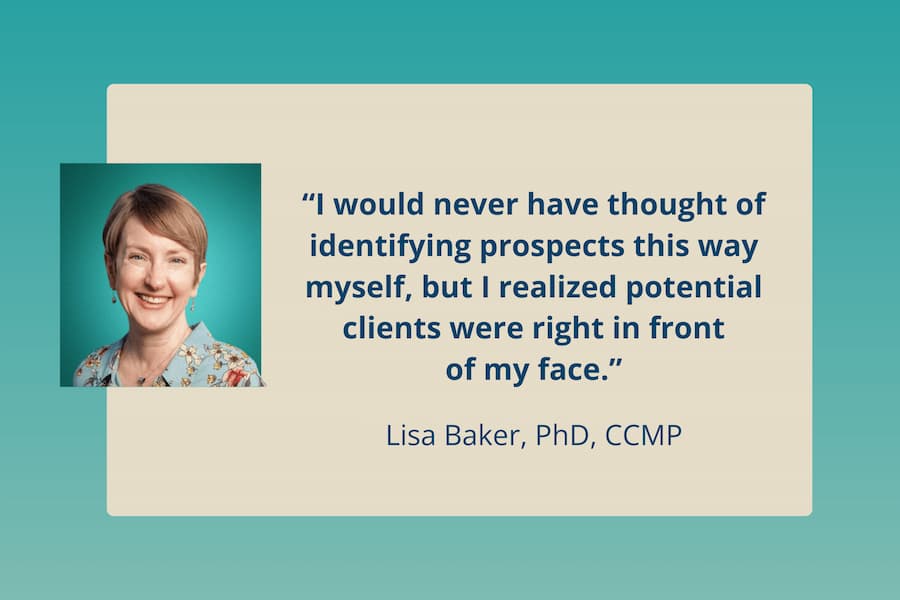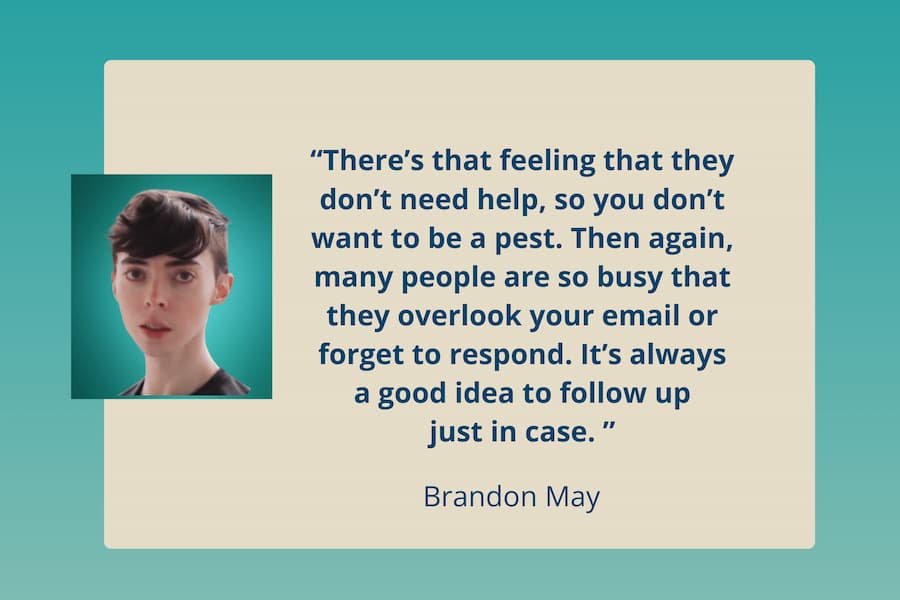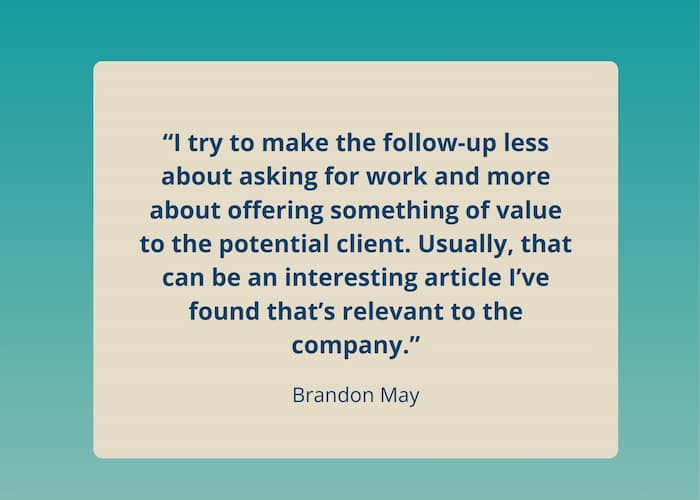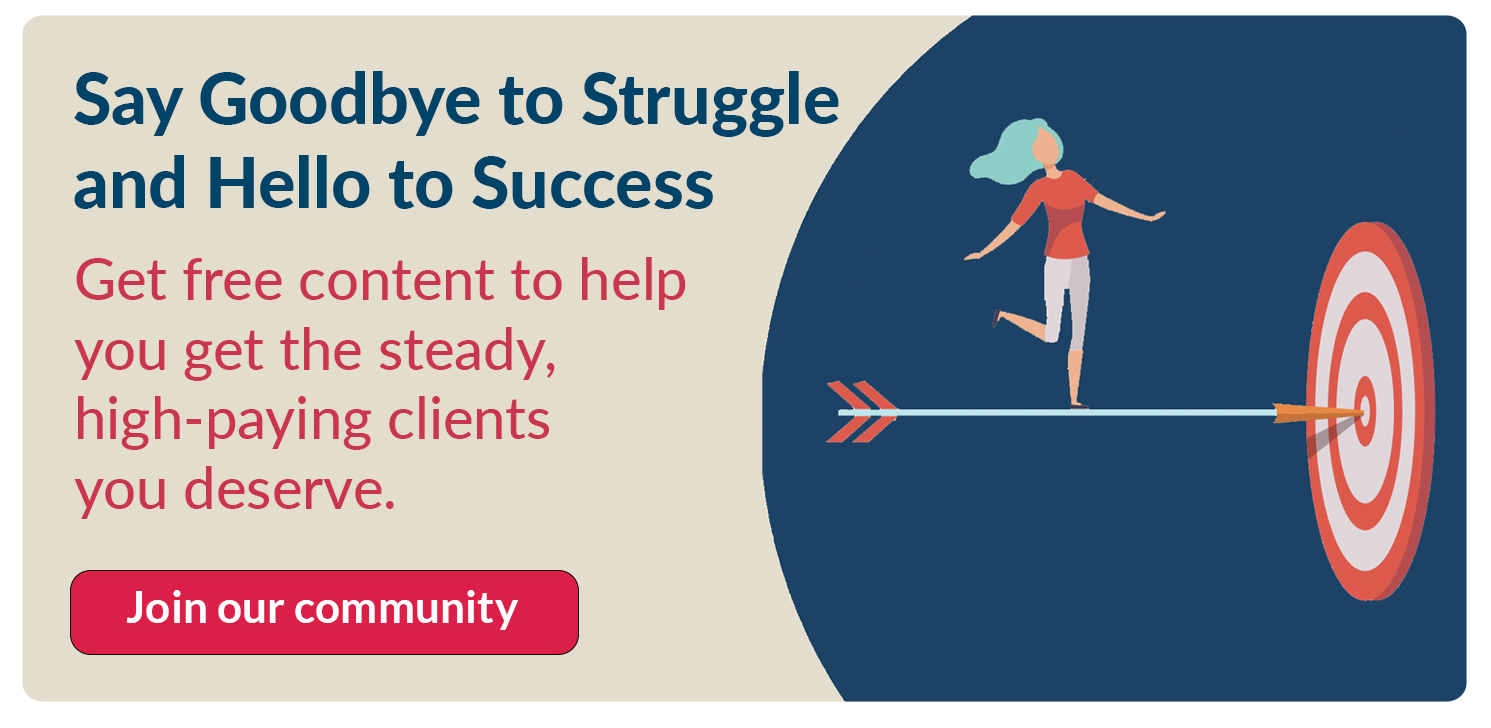The Secret Weapon that Helps 4 Freelancers Get their Ideal Clients

When done right, direct email is an awesome way to find and get steady, high-paying clients. It lets you choose the clients you want to work with and attract them by showing you understand and can meet their needs.
Just ask freelancers Kathy Adamson, Kathleen Labonge, Brandon May, and Lisa Baker. Together, the 4 freelancers have gotten 15 new clients through direct email.
Direct Email Works
Within a few months of her first direct email campaign, Kathleen got 3 clients. Kathleen is a freelance medical copyeditor and fact checker who helps her clients produce accurate, clear, and compelling content. Her company is Write Point Editing Solutions.
Kathy, owner of KMA Veterinary and Medical Writing LLC, got 4 clients through direct email in less than a year. She’s a freelance medical writer who specializes in CME, continuing education, and other veterinary and medical content.
Brandon got 7 new clients from direct email in less than a year. He’s a freelance medical writer for continuing medical education materials, medical news, and marketing materials geared toward healthcare professionals. Brandon’s company is May Medical Communications.
Lisa, a freelance medical writer specializing in publications and health economics and outcomes research (HEOR), got 1 major client through direct email.
And this blog post shows you how Kathleen, Kathy, Brandon, and Lisa are getting clients through direct email—and how you can too. It includes free resources to help you, including a direct email swipe file with templates, examples, and tips.
Turn Skepticism into Success
Like many freelancers, Kathleen and Kathy weren’t sure about using direct email at first.

Adds Kathy, “I was extremely uncomfortable with the thought of bothering people. I assumed clients already had what they needed and didn’t have time to deal with unsolicited messages.” But Kathy soon found that direct email helped her build credibility before clients met her. “People appreciate being contacted in a way that highlights their business and demonstrates how you can help them achieve their goals,” she says.
Help Clients Solve Problems
Direct email works because it focuses on helping prospective clients solve their problems, not trying to sell your services.
And it lets you choose the high-paying clients you want to work with, instead of taking whatever work comes along.
Other names for what I call direct email are warm email prospecting, cold emailing, or sales emails. Whatever you call it, direct email is a fast, free, proven way to get high-paying freelance clients.

Choose Your Ideal Clients
When you develop your prospect list(s), you’re choosing the clients you want to work with. So you can focus on better clients who can pay you what you’re worth.
“I can target the type of companies I want to work with, and I know that my direct email will resonate with them if they have a need I can help with,” says Kathy. “It’s a win-win.”
Explore opportunities and develop an action plan
Developing your prospect list(s) is a lot of work—but it’s worth it. “This may seem strange, considering how tedious and time-consuming this process can be, but I love researching new companies and seeing what’s out there,” says Brandon.
Having a prospect list gives Kathleen a plan of action and a way of measuring how she’s doing. “Developing the prospect list is a lot of hard work. But to me, it’s almost like a scorecard,” she says. “I have a big list and I keep track of who I contacted and when, the response, and where I am with each person. This lets me see what I’ve done and where I’m going.”

Develop Your Prospect List(s)
You can have one or several prospect lists. If you’re targeting the same type of clients, then you’ll have one list. If you’re targeting different types of clients, then put each type of client in a separate list.
For example, Brandon has separate prospect lists for continuing medical education agencies and medical news publishers. And Lisa has one list for agencies working in medical publications.
There are many ways to find prospects. Kathleen, Kathy, Brandon, and Lisa used:
- Industry directories
- Professional association membership directories
- The exhibitor’s list from a professional association’s annual meeting
- Online lists.
Kathleen started with an industry directory. After finding the companies she wanted to work with, she used each company’s website, LinkedIn, and the directory of a professional association to search for the right contact person/people.
Kathy used general web searches, LinkedIn, and professional association member directories to find prospects.
LinkedIn is Brandon’s main source for prospects. He searches for companies he wants to work with and then he searches for the right contact person/people within each company.
Lisa focused mostly on professional associations to find prospects.
Membership directories of professional associations are usually the easiest way to find prospects. With a membership directory, you can quickly find companies to target and everything you need to reach out to them:
- The name of the right contact person/people
- The email address for each contact person (usually).
Lisa started with the list of exhibitors at the association’s annual meeting. Many of the exhibitors do the same type of work she does. Then she used the association’s membership directory and LinkedIn to find the right contact person.
You may not always be able to find the right contact person, as Kathleen learned. “Finding the contact people is not always easy. Some companies I couldn’t contact,” she says. If that happens to you, just move on to the next prospect.
How to find email addresses
Finding a contact person’s email address can be difficult if you’re not using a membership directory (or if you’re using one that doesn’t list the email addresses of members).
So I’ll share a trick I’ve found that usually works.
Find the email format for company email addresses on its website. This is usually something like:
- firstinitiallastname@client.org or
- lastname@client.org.
Try the Newsroom, which always lists media contacts, usually by name and with an actual email address. Then apply that email format to your contact’s name.
You can also use hunter to find emails (you can get up to 50 free emails per month).
Persuade Your Ideal Clients to Hire You
Kathleen, Kathy, Brandon, and Lisa all write direct emails that:
- Are customized to each client
- Show they understand the client’s needs
- Show how they can help the client meet its needs.
A few minutes of research on each prospect’s website will give you the information you need to customize each email, as long as you already understand the industry. If you don’t know enough about the industry or the type of clients you’re targeting, do some general research before using direct email.
How to write direct emails
Write a short, targeted direct email to each prospect that has:
- A compelling, client-focused subject line
- A sentence showing that you understand the organization’s needs
- 1 or 2 sentences about your most relevant experience and how this enables you to meet the client’s needs
- A link to your client-focused website (or your client-focused LinkedIn profile if you don’t have a website yet) so that the prospect can easily learn more about you
- A call to action that clearly says what will happen next (e.g., “Should we schedule a call next week to discuss this?”).
Get direct email templates, examples, and tips
Be First in Line for Freelance Work
Find more freelance clients by following up with prospects who:
- Don’t respond to your first direct email
- Are interested in your services but haven’t hired you yet (interested prospects).
This is one of the most important things you can do!
Follow up on the first direct email
Most responses to direct email come from the follow-up emails.
If you don’t hear back from a prospect, follow up about a week later. Send a short, polite email with your original email forwarded below that. Doing this may feel uncomfortable, but it works.

“Follow-up is definitely important,” adds Kathleen, who’s gotten positive responses from her follow-up emails. “Not everybody catches your email the first time. They may be on vacation or their inbox is jammed.”
The Direct Email Swipe File also has examples of follow-up emails.
Continually follow-up with interested prospects
Up to 90% of the time, clients aren’t ready to hire a freelancer when you first contact them.
By keeping in touch with prospects who’re interested in your services but haven’t hired you yet, you’ll be the first freelancer they think of when they do need freelance help.
“I’ve had 2 clients contact me more than a year after the initial email saying they needed assistance, and they’re now my biggest clients,” says Brandon.
This has happened to me too, and to many other freelancers I know.

This is the right way to do follow-up, which should be about being helpful, not “selling yourself.”
Brandon sends prospects articles that would be helpful to them and comments on company news he learns about by checking the company’s website. Other great resources to share are relevant reports, blog posts, and podcasts.
Learn more about effective follow-up
How to be First in Line for Freelance Work
Get the Clients You Deserve with Direct Email
Kathleen, Kathy, Brandon, and Lisa are all using direct email to get the high-paying clients they deserve. If you’re willing to do the work, you can too.
But you’re not going to get clients by sending 5 or 10 emails now and then.
“It’s kind of a numbers game,” says Brandon, who usually gets 1 or 2 new clients for every 100 direct emails he sends. He does even better when he targets companies that he knows work with freelancers. In one case, he got a freelance job the day after he sent the email. But it’s hard to be sure a company uses freelancers unless you know another freelancer working for the company.
Too much work?
You may be thinking that direct email is just too much work. But you only need to get a few, steady-high paying clients to have a stable, successful freelance business.
And consider the value of each new client. For example, if you earn $20,000 a year for 5 to 10 years from a client you got through direct email, isn’t it worth the time to do direct email?
In my freelance business, I made about $1.8 million from one client that I got through direct email. We worked together for more than 18 years. Another client I attracted through direct email paid me about $200,ooo over five years. So my results definitely justified the time I put into direct email.
“I was stunned at the response,” says Kathleen. “Getting a response was a victory, even if they told me they didn’t use freelancers.” Some prospects asked her to check back in a few months.
Lisa only sent out 6 direct emails. Before you get too excited, her results aren’t typical. The client that hired her had recognized her name from volunteer work she had done for a professional association they both belong to.
And one of Kathleen’s new clients is a member of one of her professional associations. Mentioning this in her direct email likely contributed to the positive response.
Networking, especially through professional associations, can be more important than anything else in getting high-paying clients.
Learn More About Networking
Professional Associations: The Best Way to Get High-Paying Freelance Work
What Happens When You Play Nice (Give More, Take Less)
If you develop a list of about 200-400 good prospects and follow the direct email process described here, you should get a few new clients. This could happen within days or months, or it could take a year or more. If you’re looking for a lot of clients, develop another prospect list and repeat the process.
Grow Your Freelance Business with Direct Email
Direct email is an awesome way for Kathleen, Kathy, Brandon, and Lisa to get new clients and grow their freelance businesses. “I can’t think of a better way to get the word out about your business,” says Kathleen.

“Don’t be afraid to reach out to people you don’t know,” says Brandon. “There’s plenty of work out there that needs to be done, and many people need an outside resource to get it done. You could be their saving grace.”
Kathy sends some direct emails every week. “Doing this serves as an anchor in my work week and keeps the wheels of my business churning even while I’m working on projects,” she says. “I am excited about direct emails now! I can’t wait to open the responses I get.”

Learn More About Direct Email
How to Choose Your Clients Instead of Taking Whatever Work Comes Along
How to Get Steady, High-Paying Clients with Direct Email
FREE TOOL: Direct Email Swipe File
hunter email finder
Professional Associations: The Best Way to Get High-Paying Freelance Work
What Happens When You Play Nice (Give More, Take Less)
How to be First in Line for Freelance Work
This Is What Happened When One Freelancer Tried Social Selling
Learn More About Kathleen, Brandon, Malaika, and Lisa
Kathleen Labonge
Gaining Confidence and Focus: Case study
Kathy Adamson
Making the Impossible Possible